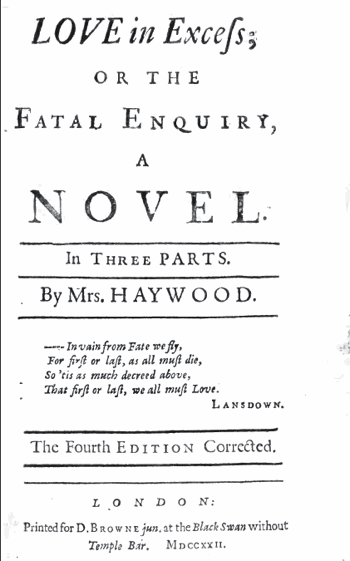Excessive women: The novels of Eliza Haywood, Charlotte Lennox, and Elizabeth Inchbald
 |
| Eliza Haywood by George Vertue, 1725 |
Part 1: Eliza Haywood's Love in Excess (1719-20)
The vilification faced by women of that era who chose occupations such as actress or writer was experienced quite directly by Eliza Haywood, who was both an actress and a writer. Women were supposed to remain in the private domestic sphere; to venture into the public literary world was to transgress on a male domain.
For her temerity Haywood was mocked by Henry Fielding in his play The Author's Farce (1730) in the character of Mrs. Novel. (Haywood evidently wasn't, or couldn't afford to be, offended; she and Fielding worked together before and after this play was performed.) And she features in Pope's Dunciad (1728) undisguised as "Eliza," where she is the prize for a (literal) pissing contest between booksellers.
Pope's poem portrays Haywood with "Two babes of love close clinging to her waist" [1]. Haywood indeed had two children by men other than her husband: the first was probably fathered by the writer Richard Savage, and the second by her long-term lover, the writer and actor William Hatchett. There is some question, actually, despite Haywood's claim that she turned to writing as a result of "an unfortunate marriage" [2], whether there ever was a Mr. Haywood. According to scholar Christine Blouch, Haywood's contemporaries believed that she had been abandoned by her husband, while her own accounts are somewhat inconsistent: in addition to the "unfortunate marriage" comment, which suggests that she may have left him, there is another reference in her surviving letters to becoming a widow at a young age. However, no marriage records for Haywood have ever been found.
Perhaps, then, drawing on personal experience, Haywood made the power of erotic passion to overcome social and religious proscriptions the subject of her first and most successful novel, Love in Excess. Published when Haywood was (probably) 26, it relates the amorous misadventures of the dashing roué Count D'elmont, whose powerful attractions cause the ladies of his acquaintance to "curs[e] that custom which forbids women to make a declaration of their thoughts." [4] In spite of these societal strictures, Alovisa (a form of Héloise) sends D'elmont an anonymous note declaring her love for him. D'elmont, though, mistakenly believes that the note comes from another beauty, Amena, pursues her with the aim of seduction, and comes close to succeeding:
"...all nature seemed to favour his design...[Amena] had only a thin silk night gown on, which flying open as he caught her in his arms, he found her panting heart beat measures of consent, her heaving breast swell to be pressed by his, and every pulse confess a wish to yield; her spirits all dissolved, sunk in a lethargy of love; her snowy arms, unknowing, grasped his neck, her lips met his half way, and trembled at the touch; in fine, there was but a moment betwixt her and ruine..." [5]One of the remarkable things about Haywood's novel is how steamy the love scenes are; later in the century, as novels became more respectable, women writers would not venture to describe erotic pleasure so explicitly. Another remarkable feature is the presumption of the equality of desire in women and men. Later in the novel D'elmont has fallen in love with his young ward Melliora, and she with him; their feelings are not only semi-incestuous (since he is her guardian), on his part they're entirely adulterous (since he has married in the meantime). Both characters realize that their shared passion is "wrong," but are (almost) helpless to restrain their mutual desire:
"As they were passing thro' a walk with trees on each side, whose intermingling boughs made a friendly darkness, and every thing undistinguishable, the amorous D'elmont throwing his eager arms round the waist of his (no less transported) Melliora, and printing burning kisses on her neck, reaped painful pleasure, and created in her, a racking kind of extasie, which might perhaps, had they been now alone, proved her desires were little different from his." [6]
 |
| Detail of the frontispiece to the 4th edition (1722), by E. Kirkall |
Next time: Charlotte Lennox and The Female Quixote (1752).
----
1. Alexander Pope, The Dunciad, Book 2, line 150.
2. Christine Blouch, "Eliza Haywood and the Romance of Obscurity." SEL Studies in English Literature 1500-1900, v. 31 no. 3, Summer 1991, p. 539.
3. Blouch, p. 544.
4. Eliza Haywood, Love in Excess; Or, the Fatal Enquiry. David Oakleaf, ed. Broadview Press, 1994, p. 41.
5. Haywood, p. 63.
6. Haywood, p. 127.
7. Haywood, p. 191.













No comments :
Post a Comment